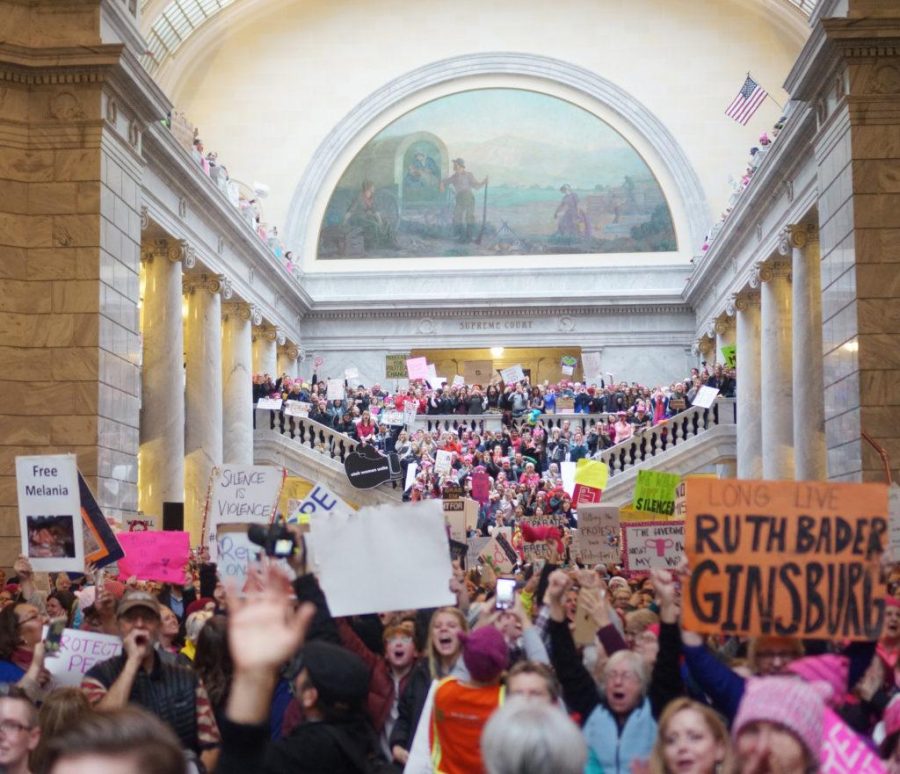“Welcome to your first day.”
That was the message that thousands of protestors sent to Utah’s elected officials on Monday, the first day of legislation, while they marched for human rights.
It was snowing when participants in pink knitted “pussy hats” met at City Creek Park before pouring onto state street. The citizens then proceeded to the steps of the Utah State Capitol in a demonstration organized by Utah Women Unite.
The march happened just two days after an estimated 8,000 marched in Park City, alongside millions worldwide in solidarity with women and those who experience oppression.
Estimates have put the total attendance of the march at as high as 6,000 according to police.
Motivations for the march were diverse, as demonstrated by a variety of messages written on card-stock and posters.
One woman held a sign that read, “Equality: All people, all nations, all colors” while another man’s said, “America Needs A Morning After Pill.”
Some signs were more direct: “Chaffetz: Your oversight is showing,” referring to Rep. Jason Chaffetz, who is the chairman of the United States House Committee on Oversight and Government Reform.
The march comes at a crucial time when the country is transitioning to a new presidential administration. In the hours prior to the march, President Donald Trump signed an executive order banning federal funding to international groups that discuss or perform abortions.
“Hours ago, the President of the United States, surrounded by men, signed an executive order which will affect reproduction rights internationally,” Jim Dabakis, a Utah state senator, told the crowd.
Among the thousands who participated in Monday’s march, several were U students. One of them, an international studies senior who wished to remain anonymous, said she learned about the march when a friend shared the event on Facebook.
Another student, a senior studying physics, learned of the event through the Physics and Astronomy Club, which was created with a goal to empower women in traditionally male-dominated sciences.
“That’s the whole reason we created the [Physics] club,” she said. “To strengthen the female voice in STEM fields.”
Both students said they marched to send a message to Utah — a message that women, and other marginalized identities, will be heard.
“I think [marching] is uniting a lot of people,” the international studies student said.
Aside from empowering women, the march focused on inclusivity, intersectionality and representation of all people, according to human rights lawyer and activist Kate Kelly.
Kelly, who helped organize the march, said that intersectionality looks at the way social characteristics like class, race, gender and ability overlap each other and contribute to different degrees of oppression.
Rep. Sandra Hollins of the Utah State Legislature, who is African American, reminded the crowd that while white women have been fighting for a seat at the table, she and “so many of [her] black American sisters are fighting to still get in the room.”
“Intersectional feminism takes into account all of the intersectional ways women are oppressed,” Kelly said. “That includes class, that includes race, that includes level of ability. The feminist analysis is not complete unless it includes all of those intersecting identities.”
Carol Surveyor, who spoke at the march, understands the need for an intersectional understanding of feminism. In 2015, Surveyor’s mother, 63-year-old Maranny “Marena” Hatalie Holiday, was killed on the Navajo Nation in southeastern Utah.
According to data from the National Institute of Justice, over 84 percent of American Indian women have experienced violence at some point in their lives. Over 56 percent have experienced sexual assault or violence.
Surveyor said she agreed to speak at the march to honor her mother and her legacy.
“We are our mother’s daughters,” she said. Surveyor’s statement was met with cheers and screams.
In terms of policy, Surveyor wants to see protections for women, like the Violence Against Women Act (VAWA), put in place. She is weary of the new presidential administration, pointing out that Jeff Sessions, President Trump’s pick for attorney general, voted against the act in 2013.
“VAWA protects Native American women,” Surveyor said. “It is very important to Native women.” Surveyor, who is involved with the Utah League of Native American voters, an organization that pushes for understanding of policies related to indigenous populations, said she wants to hold federal and local lawmakers accountable.
Sen. Dabakis announced that he will be drafting an Equal Rights Amendment that protects against discrimination of sex.
“No one could be against that,” he said.
Among supporters of the Women’s March movement, there were a few dissenters present at the Capitol on Monday.
Charlotte Mueller, who held a “Trump-Pence” campaign sign on the Capitol steps, said the march and its aims do not represent her. It also doesn’t represent all women, she said.
“There are many women who voted for Donald Trump,” she said. “[The marchers] are for abortion. I don’t support that.”
Reports have shown around 43 percent of women voters voted for Mr. Trump. It is worth noting however, that they were overwhelmingly white women. Exit-poll data shows that 94 percent of black American women voted for Hillary Clinton, along with 68 percent of hispanic women.
“We are here to embrace each other and support each other,” Hollins said. “Whether you choose to be a stay-at-home mom, or whether you choose to be the CEO of a company, you have the power to make a dream.”
c.richards@dailyutahchronicle.com


